Indoor futsal courts offer controlled conditions and year-round play, while outdoor courts provide cost-effective solutions with natural ventilation. Both can benefit from infill-free artificial turf that eliminates maintenance hassles and provides superior playing performance.
The popularity of futsal continues to grow worldwide, captivating players with its fast-paced, high-skill gameplay that demands quick thinking and precise ball control. As clubs, schools, communities, and individual investors recognize this trend, they face a crucial decision that can make or break their project’s success: should they build an indoor or outdoor futsal court?
This choice extends far beyond simple preference. It impacts everything from initial investment costs to long-term operational success, player experience to maintenance requirements. I’ve spent years helping clients navigate this decision, and I’ve seen how the right choice can transform a good investment into a great one.
The game-changer in this decision has been the emergence of infill-free artificial turf technology. This revolutionary surface material is reshaping how we think about both indoor and outdoor courts, offering solutions that were simply impossible with traditional surfaces.
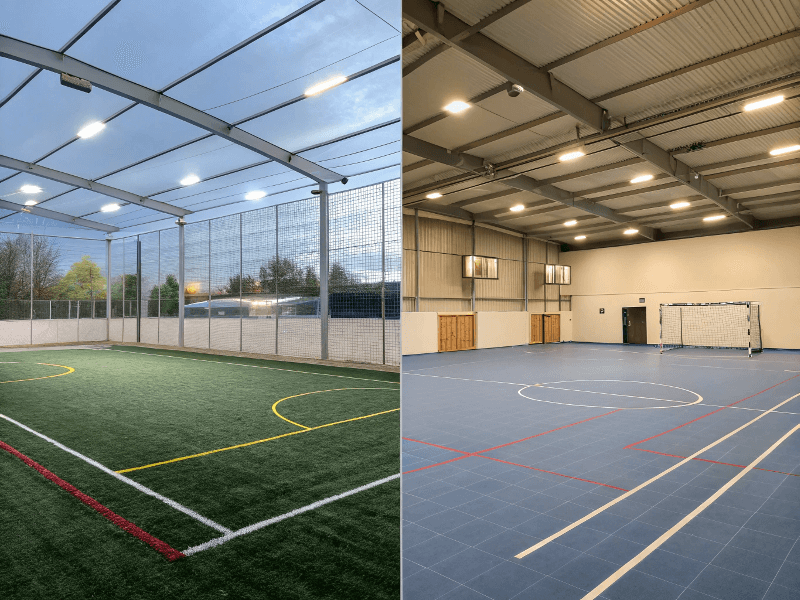
Whether you’re planning your first court or expanding an existing facility, understanding these fundamental differences will guide you toward the choice that best serves your goals, budget, and community needs.
What Makes Indoor Futsal Courts the Premium Choice?
Indoor futsal courts provide complete weather independence, extended operating hours, and premium player experience through controlled temperature, lighting, and surface conditions. They offer the highest commercial potential but require greater initial investment.
Climate Control and Consistent Playing Conditions
Indoor courts eliminate weather as a variable entirely. I’ve worked with facilities where players train at 6 AM in winter storms and compete at noon during summer heat waves, all in perfect 72-degree comfort. This consistency means:
- Temperature Control: Optimal playing conditions year-round maintain player performance and comfort
- Humidity Management: Prevents surface condensation that can create dangerous playing conditions
- Zero Weather Delays: Games and training sessions proceed regardless of rain, snow, or extreme temperatures
- Consistent Ball Behavior: Stable conditions ensure predictable ball bounce and roll characteristics
Extended Revenue Opportunities
The controlled environment of indoor courts creates multiple income streams that outdoor facilities simply cannot match. Professional lighting systems enable evening leagues, while climate control supports year-round programming.
| Revenue Stream | Indoor Potential | Outdoor Limitations |
|---|---|---|
| Evening Leagues | Full capacity 6-10 PM | Limited by daylight, weather |
| Tournament Hosting | Premium events year-round | Seasonal, weather-dependent |
| Multi-Sport Usage | Basketball, handball, events | Limited versatility |
| Corporate Rentals | Climate-controlled comfort | Weather risk |
Premium Playing Experience
Indoor surfaces, especially when using infill-free artificial turf, deliver the most consistent playing experience possible. The ball rolls true, players can rely on predictable surface conditions, and the absence of wind or sun glare allows for pure skill development.
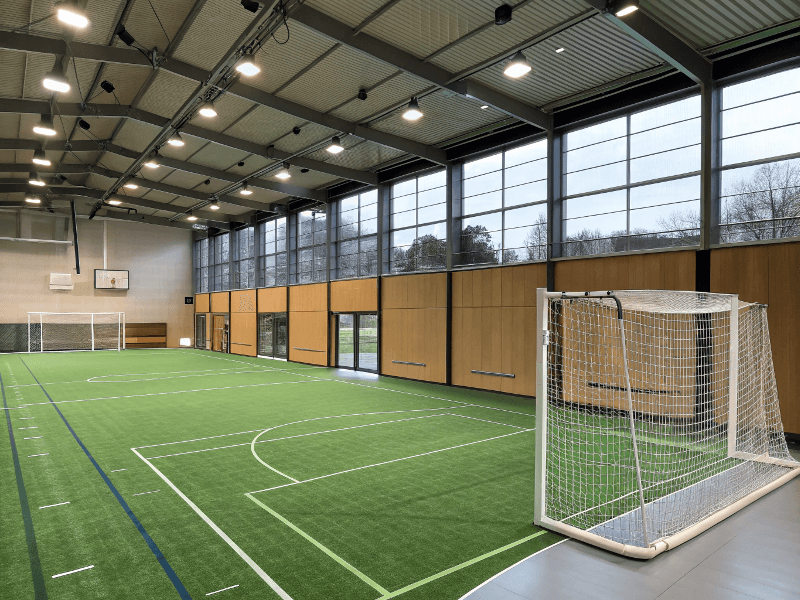
The investment in indoor infrastructure pays dividends through higher rental rates, increased booking frequency, and the ability to attract serious players and tournaments that demand professional-grade conditions.
Why Choose Outdoor Futsal Courts for Community Access?
Outdoor futsal courts offer significantly lower construction costs, natural ventilation, and community accessibility. They’re ideal for recreational play, youth development, and facilities prioritizing cost-effectiveness over year-round operation.
Cost-Effective Community Building
Outdoor courts eliminate the massive infrastructure costs associated with building enclosure, HVAC systems, and complex electrical installations. I’ve helped communities build quality outdoor facilities for less than half the cost of comparable indoor courts.
The economics are compelling for community-focused projects:
- Lower Initial Investment: No building structure, roofing, or climate control systems required
- Reduced Utility Costs: Natural lighting during day hours, no heating or cooling expenses
- Simplified Permitting: Fewer building codes and regulations compared to enclosed structures
- Faster Construction: Weather permitting, outdoor courts can be completed in weeks rather than months
Natural Environment Benefits
Enhanced Air Circulation and Open Space Feel
Outdoor courts provide unlimited fresh air circulation, eliminating concerns about indoor air quality or ventilation system maintenance. Players enjoy the psychological benefits of open space and natural surroundings.
Flexible Community Integration
Outdoor courts integrate naturally into parks, school campuses, and community centers. They become gathering spaces that serve multiple community functions beyond organized sports.
| Community Benefit | Outdoor Advantage | Indoor Limitation |
|---|---|---|
| Public Access | Open, welcoming appearance | May seem exclusive or private |
| Multi-Use Potential | Events, festivals, gatherings | Limited by building capacity |
| Maintenance Visibility | Community can see upkeep needs | Hidden operational costs |
| Youth Accessibility | Always visible and available | Operating hours restrictions |
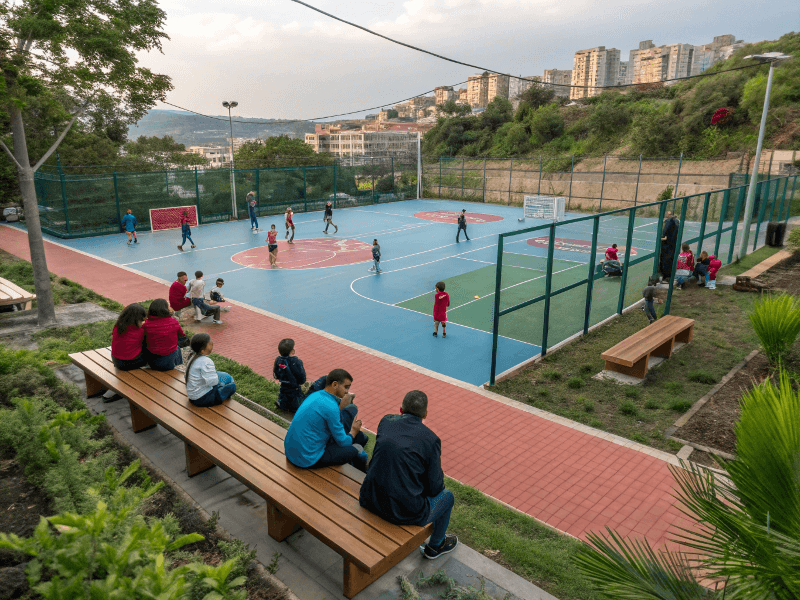
Outdoor courts excel when the primary goal is providing accessible recreational opportunities rather than maximizing commercial revenue. They serve communities that value inclusion and cost-effectiveness over premium amenities.
How Does Infill-Free Artificial Turf Transform Both Options?
Infill-free artificial turf eliminates the maintenance and health concerns of traditional filled systems while providing superior playing performance. This technology makes both indoor and outdoor courts more cost-effective and environmentally friendly.
Traditional artificial turf systems require thousands of pounds of rubber granules or sand infill to provide cushioning and keep grass fibers upright. These filled systems create ongoing problems that infill-free technology completely eliminates.
Revolutionary Design Eliminates Traditional Problems
Infill-free turf uses high-density, high-tensile strength curved and straight fibers woven together with elastic backing layers to provide cushioning and fiber support without any fill material. This fundamental design change solves multiple chronic issues:
Safety and Health Improvements:
- No rubber particles to inhale during intense play or enter cuts and scrapes
- Eliminates concerns about tire-derived rubber containing heavy metals or carcinogens
- Prevents particles from entering eyes, shoes, or clothing during sliding tackles
- Creates cleaner playing environment with no loose material migration
Environmental Benefits:
- Prevents microplastic pollution from migrating fill particles
- 100% recyclable at end of service life without separation of mixed materials
- No ongoing environmental impact from particle loss during play or maintenance
- Eliminates disposal challenges of contaminated infill material
Superior Performance Characteristics
The dense fiber construction of infill-free systems provides more consistent ball roll and player footing than traditional filled surfaces. Without loose particles, the surface maintains uniform characteristics across the entire court.
| Faktor Kinerja | Infill-Free Advantage | Traditional Fill Problems |
|---|---|---|
| Ball Roll Consistency | Uniform surface, predictable bounce | Variable due to particle migration |
| Player Traction | Stable, even grip | Inconsistent as fill shifts |
| Surface Durability | Fibers maintain position | Requires regular grooming/refill |
| Cleaning Ease | Simple surface cleaning | Particles trap dirt and debris |
Maintenance Revolution for Both Indoor and Outdoor
The maintenance benefits of infill-free turf are particularly dramatic. Traditional systems require regular grooming, particle replacement, and deep cleaning that infill-free surfaces eliminate entirely.
Indoor Applications:
- No particles tracked into building HVAC systems or adjacent areas
- Simple sweeping or light power washing maintains perfect conditions
- Eliminates indoor air quality concerns from disturbed rubber particles
- Reduces facility cleaning costs and equipment wear
Outdoor Applications:
- Superior drainage without clogged fill material
- UV-resistant fibers maintain color and performance for 10+ years
- No particle loss during storms or high winds
- Eliminates groundwater contamination from fill migration
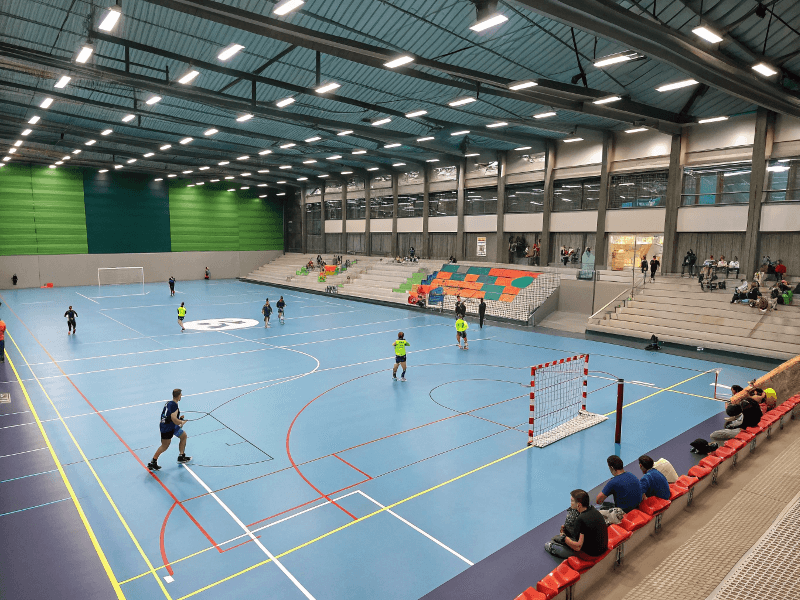
This technology represents the biggest advancement in artificial turf since its invention, fundamentally changing the cost-benefit analysis for both indoor and outdoor installations.
What Factors Should Drive Your Court Selection Decision?
Your court choice should align with budget capacity, climate conditions, target users, and operational goals. Consider both initial costs and long-term operational expenses when evaluating options.
Budget Analysis Framework
Initial Investment Considerations:
If your upfront budget is limited, outdoor courts provide the most practical entry point. However, factor in the long-term operational costs when making this decision.
Indoor courts typically cost 2-3 times more initially due to building construction, but they generate significantly higher revenue potential. Outdoor courts cost less upfront but may have weather-related revenue limitations.
Long-term Operational Costs:
Indoor facilities carry higher utility costs for lighting, climate control, and ventilation systems. However, they also generate more consistent revenue streams that often offset these expenses.
Outdoor courts have minimal ongoing operational costs but may require more frequent surface maintenance depending on climate exposure and fill system type.
Climate and Geographic Factors
Weather Pattern Analysis:
Your local climate patterns should heavily influence this decision. I always advise clients to consider their region’s weather challenges:
- High Precipitation Areas: Indoor courts eliminate weather-related cancellations and revenue loss
- Extreme Temperature Regions: Climate control becomes essential for player comfort and participation
- Mild, Stable Climates: Outdoor courts can operate effectively year-round
- Windy Locations: Indoor facilities provide better playing conditions for technical skill development
Target User Groups and Usage Patterns
Commercial vs. Community Focus:
Your intended user base determines which features matter most:
Professional/Competitive Focus:
- Requires consistent playing conditions for skill development
- Benefits from extended operating hours and premium amenities
- Justifies higher facility costs through premium pricing
- Indoor courts typically better serve these needs
Community Recreation Focus:
- Prioritizes accessibility and inclusive pricing
- Benefits from natural integration with community spaces
- Values cost-effectiveness over premium amenities
- Outdoor courts often better serve these goals
| User Type | Indoor Priority | Outdoor Priority |
|---|---|---|
| Youth Leagues | Consistent conditions | Accessible costs |
| Adult Recreation | Extended hours | Community feel |
| Tournament Play | Professional standards | Lower entry fees |
| School Programs | Weather independence | Budget constraints |
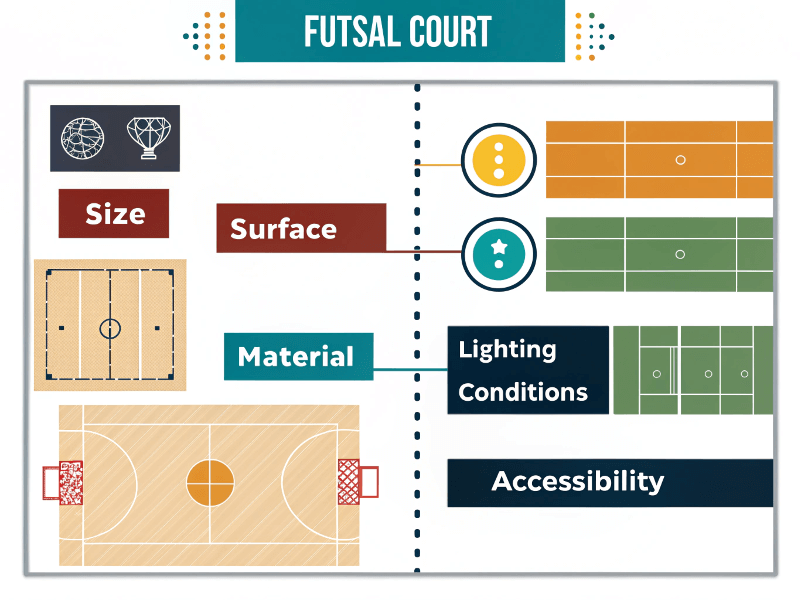
The most successful facilities align their court type with their primary user base’s priorities and budget constraints.
Kesimpulan
Indoor and outdoor futsal courts each offer distinct advantages that serve different community needs and business models. The key is matching your choice to your specific goals, budget, and local conditions while leveraging modern technologies like infill-free artificial turf to maximize performance and minimize maintenance regardless of your selection.
Ready to transform your futsal vision into reality? Contact us today for a personalized consultation, detailed cost analysis, and free infill-free artificial turf samples. Our team of specialists will help you make the right choice for your specific needs and budget. Don’t wait – let’s build the perfect futsal court for your community together.
Get Your Free Quote and Samples Now →
